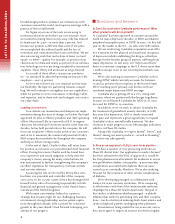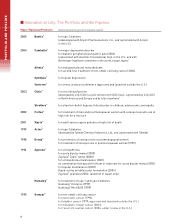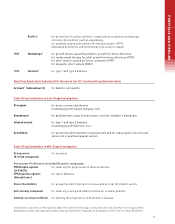Eli Lilly 2005 Annual Report Download - page 4
Download and view the complete annual report
Please find page 4 of the 2005 Eli Lilly annual report below. You can navigate through the pages in the report by either clicking on the pages listed below, or by using the keyword search tool below to find specific information within the annual report.
2
LE T TER TO SHARE HOLDERS
Sidney Taurel
Chairman of the Board and Chief Executive Officer
Prepared for the Future
The intense pressures on the pharmaceutical industry
that I have discussed with you over the past few years
continued unabated in 2005. Several factors are at play.
First, payers around the world are struggling with
the costs of health care in general and drugs in particular.
In the European Union and Japan, aging populations
are straining health care budgets, and governments are
pursuing policies that hold down prices of and access to
innovative medicines.
In the U.S., pressure on payers—whether employers,
states or the federal government—is also intense. The new
Medicare Modernization Act will profoundly change how
drugs are paid for in the U.S. Starting in January, Medicare
for the first time began providing prescription drug cover-
age for more than 42 million people over age 65 or with
disabilities. As a result, the percentage of Lilly’s drugs paid
for by federal and state governments in the U.S. will rise
from 33 percent to about 50 percent. While we may see
some modest near-term benefit from the MMA, we antici-
pate ongoing pressure on our prices over the long term.
Second, in the wake of some antidepressants being
associated with suicidal thoughts as well as the with-
drawal of Vioxx®, concerns over safety are overwhelming
any sense of balance with efficacy in the media and
among politicians—and this in turn has made regulatory
agencies more cautious. For example, in 2005 the FDA
required 60 black box warnings be added to product
labels—nearly triple the 21 it required in 2003.
Third, these challenges come during a period when
the industry is struggling to produce new drugs. For
example, in the five years from 2001 to 2005, the FDA
approved nearly 40 percent fewer new molecular enti-
ties than in the preceding five-year period. In addition,
in this decade the industry will lose patent exclusivity
on products with annual sales of some $100 billion. As
a result, global pharmaceutical sales growth has slowed
from the strong double-digits in the late ’90s to the single
digits today and into the foreseeable future.
In this industry environment, Lilly delivered adjusted
earnings-per-share of $2.87, up 11 percent over 2004.
This compares with about 7 percent EPS growth average
for large pharmaceutical companies as a whole. (For a
reconciliation of our adjusted EPS to the reported EPS of
$1.81, please see page 1.) This performance was the result
of 6 percent sales growth, disciplined expense control and
increased productivity.
In addition, in 2005 we moved past major uncer-
tainties—several involving Zyprexa®, our top-selling
product. The U.S. district court in Indianapolis emphati-
cally reaffirmed the validity of our Zyprexa patent and
we announced a tentative settlement of the bulk of our
U.S. product liability litigation involving this important
product. The CATIE study—a seminal comparison of
antipsychotics conducted by the National Institute of
Mental Health—concluded that patients in the study tak-
ing Zyprexa were more likely to stay on their medication
than patients taking other antipsychotics studied, and
were less likely to be hospitalized for a psychotic relapse.
In addition, after a series of successful inspections of
our global manufacturing sites, the FDA has strongly
endorsed our manufacturing and quality improvements.
Focus on innovation bears fruit
Lilly has distinguished itself with the innovation-
driven strategy we have implemented for the past decade.
We chose to remain independent; to invest in R&D at the
top of the industry with the goal of delivering a steady
flow of innovative products; to build the capabilities to
manufacture these products and market them effectively

















